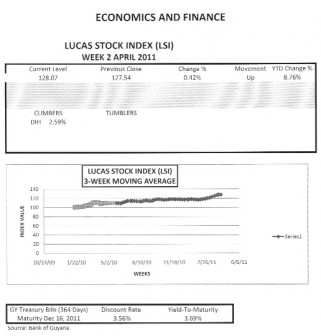Happy
Not too long from now Sterling Products Limited (SPL) will convene its Fifty-Sixth Annual General meeting to consider the performance of the company in 2010 and deliberate on plans perhaps already underway for 2011. While the general public has to wait to hear the results of the performance of SPL in 2010, its 663 shareholders on record probably already know what to expect when they meet shortly from now. The company, which is part of the Beharry Group of companies, has been turning in impressive returns on increasing sales and lower costs in recent years. The year 2008 saw a 49 percent increase in pre-tax profits while 2009 saw a whopping 233 percent increase. Fuel is a critical input in the production operations of SPL and 2010 was not an outrageous one for the price of fuel as was 2008. Comparing 2010 to 2009, a year of continued global economic uncertainty, shareholders should be happy since it means that they could expect to see even better returns than in 2009 and a positive outlook for 2011. Despite the reasons for optimism, shareholders should wonder if SPL is not being too complacent about its readiness to compete and build shareholder value.
Raise Eyebrows

This query stems from a series of observations that ought to raise the eyebrows of investors and make them wonder about the competitive readiness of SPL. The company has done plenty to give itself a chance to compete and win. SPL has spent time improving the quality and appearance of the products that it produces by improving its production facilities. Not only has it upgraded plant facilities, it has also built new plants and acquired new machinery to improve the efficiency of its operations and the quality of its products. An indication of its commitment to quality is the acquisition of the certification of the International Organization of Standards (ISO) for its products. SPL has also invested in its staff by ensuring that it was well trained and suitably remunerated. These initiatives, together with those of redesigning and repackaging its products for greater market appeal and improving the distribution of the company’s products, have helped SPL to record positive performances in recent years.
Slow
Despite its recent impressive performance, SPL might not be ready for any serious domestic or global market challenge. Innovation seems to be slow for a company which produces several commonplace products. One would think that after 56 years of doing business, SPL would have a more diverse product line than it currently has. SPL started out building its economic fortune on margarine, lard, ghee and soap in October 1954. It then took the company 13 years to add another product to its line of business, when it started producing detergent. SPL took two years thereafter to expand its product line again adding butter in 1969. SPL expanded its product line once more in 1973 when it added ice cream to the list of items that it manufactured and sold.
The stability in product offerings is good for the company but might not be good in all cases for the increasingly health conscious consumer. It was recently reported that the incidence of diabetes in Guyana was on the rise. The management of this disease could lead to a decline in demand for products like ice cream which sugar content tends to be high. Some of the health risks associated with diabetes could also result in a decrease in consumption of the edible fats in its product line.
Believe
By the time SPL holds its next general meeting, it would have been over 36 years since it last added a new instead of a re-packaged product to its line of business. This means that neither its previous majority owner nor its current majority owner of 13 years would have widened the range of products for customers in a very long time. It is not clear how much money the company spends on research and development but SPL seems to believe that its market share will continue to grow or that it would be able to continue dominating the domestic market without having to introduce new products or show a more competitive side. A review of its 2009 Annual Report offers no evidence that its business strategy appears concerned about declining demand for its products or likely competition in the future. With the apparent ability to control the pricing of its products, SPL sees no risks to itself.
Missed Opportunities
In addition, SPL has been exporting its products since 1957, yet exports do not account for more than 12 percent of its revenues. The slow growth in exports might be part of its business strategy, but it could also be reflecting missed opportunities and an unwillingness to challenge itself. It is not surprising, therefore, to see a long-standing company like SPL making a relatively small contribution to the Guyana economy. The contribution of SPL in 2009 to the Guyana economy, for example, was equivalent to less than a quarter of one percent of gross domestic product (GDP). Its position in its native environment described as “other manufacturing” in the national accounts is relatively small as well, contributing about four percent to the revenue of the sector in 2009.
Conservative
The savvy shareholders probably realize that the business strategy of SPL is a very conservative one that was unlikely to change soon. They would also know that with a book-to-market value of 1.57 that the stock in which they have invested is woefully undervalued in the stock market. Instead of increasing in value, the stock is trading seven percent lower than it was a year ago. So while the news coming out of the corporate offices at the next shareholder meeting might be good, the news from the market is not so encouraging.








